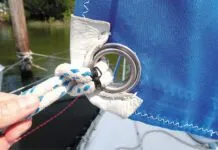Encapsulated Keels
Our Cheoy Lee 35 has an encapsulated keel. A North Channel of Lake Huron piloting error a few years ago led us to discover that the contents of the keel capsule are by no means solid. Once holed, the hollow spaces in the keel capsule allowed the incoming water to test the integrity of the fiberglas seal between the keel and the boats interior. The hull-to-keel seal on our boat failed that test and created an opportunity to exercise our damage control knowledge and our bilge pump capacity.
We drained the keel, patched the hole, reinforced the leading edge and bottom of the keel and have reglassed the leaking portions of the hull-to-keel seal. We are in the process of beefing up the hull-to-keel seal in the places where it is reasonably accessible. Unfortunately, getting at some of the seal would require complete removal of the head and the forward structural bulkhead. Not in this lifetime, thank you. Redundant high-capacity bilge pumping systems will have to suffice.
Our investigation of this problem found information that should be of interest to PS readers. First, our experience is not at all unusual. Often, an impact that is hard enough to rupture the keel capsule will flex the hull enough to loosen some of the hull-to-keel seal; usually at the leading or trailing edge of the keel. Second, the ballast found in encapsulated keels is often of nebulous origins. The good stuff includes lead shot and steel punchings. The other stuff may include sand, concrete or whatever the boat yard was trying to dispose of that week. (Knock three times if you are in there, Mr. Hoffa.) Many if not most boats with encapsulated keels will allow water to flow fairly freely from a hole in the capsule to the keel/hull seal. If that seal is not completely intact or has been ruptured by the force of the collision, water will enter the cabin.
If the seal holds, that may not be the end of it. We know of one instance where a grounding ruptured the keel capsule, however, that caused no leakage of water into the cabin. But over the next hour of sailing, the boat became more and more tender as lead shot poured out of the keel and was replaced by much lighter water.
What we need is a cure. Is there a way of injecting something into the keel that will solidify its contents? Is that a stupid idea? Wouldnt curing epoxy get too hot? How about hydraulic cement? Its got to be wet inside there, right?
Randall Tumblin
Orange Park, Florida
You raise interesting issues about encapsulated keels. We had a similar experience with a Pearson Vanguard. We hit a rock in Narraganset Bay rather lightly and didnt worry about it because no water entered the cabin. In fact, we didnt even know there was a hole in the keel.
During the next haulout, however, we saw that a hole of about 4″-6″ in diameter had been made in the lower, leading edge of the keel, the usual location. It also became apparent that the boat had been holed there before and poorly repaired as unwetted pieces of fiberglass fell apart and chunks of Bondo or some other filler fell out. Worse, water continued to weep out of the hole. After grinding away the fractured fiberglass, enlarging the hole considerably, we discovered that the builder had wedged sheets of balsa coring on either side of the lead, which, fortunately, was one piece. The balsa was soaked and it took more than a month before it dried sufficiently to effect the repair to the hole. Indeed, a number of times when the weeping stopped we thought it had dried. Wed laminate the first plies of new fiberglass over the hole, only to return the next day to find water seeping through the repair and the resin uncured.
A proper repair requires feathering the hole so that the overlap of old and new fiberglass is about 12 times the thickness (for a 1″ thick hull, the largest pieces of new fiberglass would overlap about 12″). Behind the patch we had fashioned a hardwood block that wedged against the lead.
When we finished, we drill several holes high in the cavity and poured (as best we recall) polyester resin into the cavity. We didnt attempt to fill it, but wanted to add something to the backside of the wood used to reinforce the hole patch. There was no problem after that, but we don’t know how effective these measures were.
Polyester resin does get hot, but epoxy resin no. Depending on the volume, it could be expensive to fill the entire cavity, but perhaps worth the attempt if lead shot were at large. (We don’t like the idea of shot and other loose pieces drifting around in the cavity. Nor do we like concrete, which tends to get mushy after prolonged immersion in water). And, the insides should be as dry as possible or the resin may not kick properly. This could require drilling drain holes at the keel bottom and maybe even larger windows along the sides to air it out before the repair is completed.
Suggestions are welcome from readers.




































